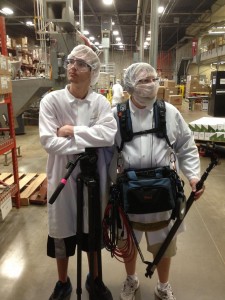It is a crucial, yet sometimes over-looked, element of a video. The sound. Here’s another lesson, this time in the art of audio, courtesy of our audio expert and partner in crime, Robb Moore (seen here in attire that proves his dedication to the job).
Q: What is it about sound that gives such power to a video?
Sound is the other side of the image. That being said–knowing when to use sound, and not, is just as powerful. Sound hits people in a different dimension as the image does, so most of the time, it’s very important.
Q: What are some common mistakes people make when it comes to audio?
Not following the motivation of the piece. If the subject is supposed to be on a phone, make it sound like a phone. If the actor has been hit on the head and it’s in their point-of-view, make it sound “blurry.” Try to get the best sound you can in the field… and don’t forget effects for post. A sound recordist should be trying to tell the story with sound, so that if someone isn’t watching the video, the soundtrack tells the entire story. Bad sound can make the video look bad, and make the work of the gaffer not shine. Sound is the third leg of the stool–so give proper attention and weight to it’s execution. Often times people obsess about cameras…but that’s only part of the project.
Q: How do you fix those mistakes?
Some mistakes can be fixed, but a lot of mistakes from the field cannot be fixed without going back to production. So get the sound, and get it right. Check meters, ask questions and listen!
Q: What are a few basic tips for good sound?
Line level. Use the highest level signal you can. It overcomes lots of problems on set. Also, exercise your preamps. Audio preamps have a sweet spot, so if you’re not running your input gain and meters close to unity, you’re not getting the quality out of the gear you should be. Sound is an active job. Don’t set levels “and forget,” keep moving! The better you do your job, the better post production will go, and the better the final product will be.
